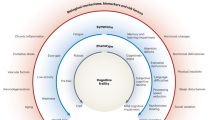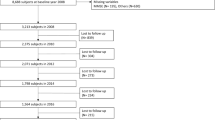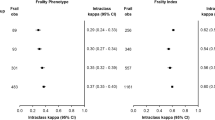Abstract
The normal course of aging is associated with gradual declines in a number of functional abilities. Patients who are at high risk of functional decline are described as frail or vulnerable. A screening tool to identify such patients is needed, as it has been shown that intervention can delay the onset and/or slow the progression of functional decline. This Review describes the methods currently available for nonspecialist evaluation of aging individuals, including behavioral, interview and questionnaire assessments. Such assessments can be undertaken during routine physician visits. In recognition of the time pressures on physicians, this article focuses on those measurements that are fairly comprehensive yet concise, easy to administer in an office setting, and available in English.
Key Points
-
Functional decline is a common accompaniment to old age, but is increasingly neither inevitable nor unmanageable
-
Screening for frailty among seniors should become a regular part of clinical encounters
-
A variety of methods of screening are available to physicians; specifically behavioral, interview and questionnaire assessments
-
These screening methods should be used in combination to screen for frailty
-
Large studies using combinations of screening methods are needed to develop an effective and efficient, but brief, protocol to screen for physical vulnerability
This is a preview of subscription content, access via your institution
Access options
Subscribe to this journal
Receive 12 print issues and online access
$209.00 per year
only $17.42 per issue
Buy this article
- Purchase on Springer Link
- Instant access to full article PDF
Prices may be subject to local taxes which are calculated during checkout
Similar content being viewed by others
References
Folstein M et al. (1975) “Mini-Mental State”, a practical method for grading the cognitive state of patients for the clinician. J Psychiatr Res 12: 189–198
Beck AT et al. (1997) Screening for major depression disorders in medical inpatients with the Beck Depression Inventory for primary care. Behav Res Ther 35: 785–791
Beck AT et al. (1997) Use of the Beck Anxiety and Depression Inventories for primary care with medical outpatients. Assessment 4: 211–219
Liang MH (1990) The measurement paradox of disability and its implication for gerontology. In Challenges in Aging: the 1990 Sandoz Lectures in Gerontology, 223–231 (Eds Bergener M et al.) New York: Academic Press
Guralnik JM et al. (2000) Lower extremity function and subsequent disability: consistency across studies, predictive models, and value of gait speed alone compared with the short physical performance battery. J Gerontol A Biol Sci Med Sci 55 (Pt A): M221–M231
Mitnitski A et al. (2005) Relative fitness and frailty of elderly men and women in developed countries and their relationship with mortality. J Am Geriatr Soc 53: 2184–2189
Fried LP et al. (2001) Frailty in older adults: evidence for a phenotype. Cardiovascular Health Study Collaborative Research Group. J Gerontol A Biol Sci Med 56 (Pt A): M146–M156
Rockwood K et al. (2005) A global clinical measure of fitness and frailty in elderly people. Can Med Assoc J 173: 489–495
Rockwood K (2005) What would make a definition of frailty successful? Age Ageing 34: 432–434
Hammerman D (1999) Toward an understanding of frailty. Ann Intern Med 130: 945–950
Saliba D et al. (2001) The Vulnerable Elders Survey: a tool for identifying vulnerable older people in the community. J Am Geriatr Soc 49: 1691–1699
Ferrucci L et al. (2004) Interventions on Frailty Working Group. Designing randomized, controlled trials aimed at preventing or delaying functional decline and disability in frail older persons: a consensus report. J Am Geriatr Soc 52: 625–634
Gill T and Kurland B (2003) The burden and patterns of disability in activities of daily living among community-living older persons. J Gerontol A Biol Sci Med Sci 58 (Pt A): 70–75
Chang JT et al. (2004) Interventions for the prevention of falls in older adults: a meta-analysis of randomised clinical trials. BMJ 328: 680–686
Sloss EM et al. (2000) Selecting target conditions for quality of care improvement in vulnerable older adults. J Am Geriatr Soc 48: 363–369
Boult C et al. (1994) A controlled trial of outpatient geriatric evaluation and management. J Am Geriatr Soc 42: 465–470
Reuben D et al. (2003) Restructuring primary care practices to manage geriatric syndromes: the ACOVE-2 intervention. J Am Geriatr Soc 51: 1787–1793
Higashi T et al. (2005) Quality of care is associated with survival in vulnerable older patients. Ann Intern Med 143: 274–281
Teno J et al. (1990) Multiple stumbles: a risk factor for falls in community-dwelling elderly. J Am Geriatr Soc 38: 1321–1325
Morley J (2003) Mobility performance: a high-tech test for geriatricians. J Gerontol A Biol Sci Med Sci 58 (Pt A): 712–714
Mathias A et al. (1986) Balance in elderly patients: the “get-up and go” test. Arch Phys Med Rehabil 67: 387–394
Saliba D et al. (2000) Identifying a short functional disability screen for older persons. J Gerontol A Biol Sci Med Sci 55 (Pt A): M750–M756
Nourhashemi F et al. (2001) Instrumental activities of daily living as a potential marker of frailty: a study of 7,364 community-dwelling elderly women (the EPIDOS Study). J Gerontol A Biol Sci Med Sci 56 (Pt A): M448–M453
RAND Corporation (2001) Assessing care of vulnerable elders: a RAND Health project. Vulnerable elders survey (VES-13) [http://www.rand.org/health/projects/acove/ve_survey.html] (accessed 20 July 2006)
Brody KK and Perrin NA (2002) The Frailty Wheel study: evaluation of a population-based screening technique modified for patient care settings. The Gerontological Society of America. Poster session: 24 November 2002
Gill T et al. (2002) Underestimation of disability in community-living older persons. J Am Geriatr Soc 50: 1492–1497
van Iersel MB and Rikkert MG (2006) Frailty criteria give heterogenous results when applied in clinical practice. J Am Geriatr Soc 54: 728–729
Acknowledgements
The authors thank Dr Matthew Liang of Brigham and Women's Hospital and Harvard Medical School, for his advice and contribution throughout the project. The work was supported by the Boulos Hanna Summer Studentship at the Royal College of Surgeons in Ireland (RCSI) and by the Healthy Aging Research Programme (a cross-institutional project funded by the Health Research Board, which also involves Trinity College Dublin, the Queen's University of Belfast and the Economic and Social Research Institute, Dublin).
Author information
Authors and Affiliations
Corresponding author
Ethics declarations
Competing interests
The authors declare no competing financial interests.
Rights and permissions
About this article
Cite this article
Corapi, K., McGee, H. & Barker, M. Screening for frailty among seniors in clinical practice. Nat Rev Rheumatol 2, 476–480 (2006). https://doi.org/10.1038/ncprheum0288
Received:
Accepted:
Issue Date:
DOI: https://doi.org/10.1038/ncprheum0288



